|
Actually, both are correct. The word "cteno"
means "comb" and "chaetus" means
"bristle." Put the two together and you get Ctenochaetus,
the name given to a small genus of surgeonfish that many consider
the best herbivore for filamentous algae in home aquariums.
They are moderately attractive, non-aggressive, grow smaller
than most Acanthurids, and are not as active as some of their
cousins. With all of these positive factors it would be hard
to go wrong in purchasing one, right? In the words of Lee
Corso, "not so fast my friend." For the July issue
of Reefkeeping and "Fish Tales" I'll dive
into the genus commonly referred to as Bristletooth or Combtooth
Tangs.
Meet the Family
As Surgeonfish, all Bristletooth tangs
can be found in the family Acanthuridae. This family consists
of three sub-families, six genera, and seventy-two species
(Michael, 1998). All species possess at least one, and possibly
three or more, potent weapons just forward of the base of
the tail, on an area known as the caudal peduncle. This weapon
is similar to a dagger and consists of modified scales. Extensive
tests have been inconclusive in showing any sort of venom
associated with this knife-like spine, but it is important
to note that in one series of observations, every fish cut
with the dagger of modified scales from members of the sub-family
Prionurinae have died as a result of the wound (Baensch, 1994).
Luckily, fish from the sub-family Prionurinae rarely make
it into the hobby. Ichthyologists use the caudal peduncle
as a distinguishing character to place each member into one
of the three sub-families. In all three sub-families the dagger
is attached closest to the base of the tail, and extends toward
the front of the fish. Having only one spine in the caudal
peduncle, all Ctenochaetus species are placed in the
sub-family Acanthurinae.
|
Sub-families:
|
Genera:
|
| Acanthurinae |
Acanthurus |
| |
Ctenochaetus |
| |
Paracanthurus |
| |
Zebrasoma |
| Nasinae |
Naso |
| Prionurinae |
Prionurus |
Ctenochaetus contains nine species
(see below), all found in the tropical Indo-Pacific. All nine
members of the genus have an unusual mouth and teeth structure.
Adults can have more than 30 teeth per jaw, and all are flexible
and slender and are described as having "expanded, incurved,
denticulate tips" (Randall and Clements, 2001) (more
on teeth later). Another notable characteristic in Ctenochaetus,
distinguishing them from other Acanthuridae, is the total
number of dorsal spines. Whereas most Acanthuridae possess
nine dorsal spines, Ctenochaetus only has eight. Similar
to most Acanthuridae, Ctenochaetids possess a very long intestine
which functions similar to a stomach, making up for the inefficient
gizzard-like stomach of the surgeonfish.
| §binotatus |
| §cyanocheilus |
| §flavicauda |
| §hawaiiensis |
| §marginatus |
| §striatus |
| §strigosus |
| §tominiensis |
| §truncatus |
|
|
Members of the genus Ctenochaetus
were discovered as long ago as 1825, but at that time they
were placed in the genus Acanthurus. In 1831 Bonaparte
erected Ctenodon, which wasn't validated until Klunzinger
(1871). Finally, in 1885, Gill changed Acanthurus strigosus
to the newly erected genus Ctenochaetus. It remained
a slow transition, however, with Ctenochaetus remaining
a small genus of only two specimens until 1955 when Randall
decided a revision was in order. In doing so, he named five
new species to bring the total to seven recognized Bristletooth
tangs. More recently, Randall has done a second revision,
in which he named two additional species, bringing the total
number of Ctenochaetus to nine.
There is a group of four Ctenochaetus
that are classified as variants of Ctenochaetus strigosus
(Randall, 1955). In 1955, Randall was tempted to opt for sub-species
status, but choose to classify them as the Ctenochaetus
strigosus complex instead. These four varieties of fish
are extremely similar. They differ by slight coloration variations
and from the locale in which they originate. Gill raker counts
and dorsal soft rays also vary slightly. Additional DNA research
is ongoing and should prove invaluable in sorting out confusions
such as the C. strigosus complex.
Ctenochaetus strigosus
allopatric species
|
Species
|
Variation
|
Location
|
| C.
strigosus |
Yellow
encircles the eye. |
Hawaiian
Islands |
| C.
cyanocheilus |
Dark
overall, with slight white coloring on tail. |
Central
Pacific Ocean |
| C.
flavicauda |
Pure
white caudal peduncle and fin. |
Eastern
South Pacific |
| C.
truncatus |
Blue/yellow
dots; truncate caudal fin. |
Indian
Ocean |
In the Wild
All Ctenochaetus species are found
in the tropical Indo-Pacific. Species can be found as far
west as the East coast of Africa (C. truncatus, C.
binotatus, C. striatus), and as far east as Panama
and Columbia (C. marginatus). Likewise, distribution
extends from as far south as New South Wales (C. binotatus)
up to Southern Japan (C. cyanocheilus). Most species
are found in less than 100 feet of water, usually occurring
in 50 feet or less. However, C. strigosus has been
reported to occur as deep as 340 feet (Randall and Clements,
2001). They prefer reef walls or steep slopes, which are often
pounded by stiff currents and clean, highly oxygenated water.
This juvenile coloration is tough to differentiate from other
possible juvenile color forms. This one
appears to be C. truncatus, but C. strigosus
is nearly identical. Once the adult color form begins
to shine through it will make identfication much easier. Photo
courtesy of Greg Rothschild
of Mother
Nature's Creations.
Although the fish in family Acanthuridae,
and subsequently the genus Ctenochaetus, are often
viewed upon as strict herbivores, this is hardly the case.
In contrast to popular belief, these unique teeth of Ctenochaetus
are not designed for consuming algae whatsoever. The teeth
are geared for rasping fine detrital material from rocks and
sand while the carp-like design of the mouth is efficient
at sucking up this detrital material. This detrital material
consists of diatoms, various small fragments of algae, large
amounts of unidentifiable organic material (as much as 90%
of one fish's stomach contents) and fine inorganic sediment
(Randall, 2001).
Juvenile Bristletooth tangs are likely
to remain in loose aggregations. They also have a specific
juvenile coloration, which gradually changes to the adult
coloration when they reach lengths around 7 or 8 cm. This
juvenile coloration is oftentimes a vibrant yellow, orange,
and blue, whereas the adults tend to manifest drab browns,
creams, and blacks. Adults generally maintain pair bonds,
except for C. strigosus, which is a solitary adult,
and are virtually identical looking. There are no external
variations to differentiate sexes; however, it has been noted
that the larger of the two will be the male (Robertson, 1985)
and in at least a few species sexual dichromatism is present
during courtship (Randall, 1961). In at least one species,
C. striatus, adults gather during the lunar cycle to
mate in small harems (Randall, 1961 and Robertson, 1983).
However, the fish in the C. strigosus complex have
been noted as spawning only in pairs (Baensch, 1994).
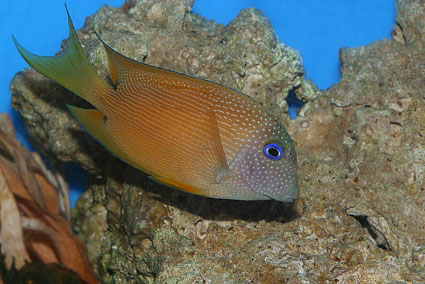 |
An adult C. binotatus is seen here. The juvenile color
form will have a bright yellow
tail and lack the spots that cover the adult. Photo courtesy
of Greg Rothschild of
Mother
Nature's Creations.
As can be expected with any fish that consume
dinoflagellates, Combtooth tangs have been reported in Ciguatera
poisoning events. In fact, this fish contains two toxins.
One is a fat-soluble toxin and the other is a water-soluble
toxin. Chromatography was used to prove the fat-soluble toxin
as ciguatoxin (Yasumoto et al. 1971). For those unfamiliar,
Ciguatera poisoning is usually associated with bottom-dwelling
shore reef fish; it the most common fish-borne seafood intoxication.
These fish feed on toxic dinoflagellates and the causative
agent, ciguatoxin, becomes concentrated in the meat of these
fish. Humans eat the meat, and the ensuing sickness is called
Ciguatera poisoning. The water-soluble toxin, which is located
in the liver, was later discovered to be maitotoxin. For those
not familiar with maitotoxin, it is contracted much the same
way as Ciguatera poisoning, but it increases the calcium ion
influx through excitable membranes such as those surrounding
nerve or muscle cells; this is not affected by tetrodotoxin
or sodium. Such a calcium influx can result in rapid death.
These substances are some of the most lethal natural substances
known. In mice, ciguatoxin is lethal at 0.45 ug/kg ip, and
maitotoxin at a dose of 0.15 ug/kg ip. Oral intake of as little
as 0.1 ug ciguatoxin can cause illness in the human adult
(as an extrapolation from fish samples eaten) (NIEHS
Marine and Freshwater Biomedical Sciences Center). So…
don't eat your Bristletooth!
In the Home Aquarium
Provided the hobbyist meets a few basic
requirements, captive care of Ctenochaetus species is quite
possible. The first step into a positive experience with these
fish is selecting a healthy specimen. Oftentimes Bristletooth
surgeonfish arrive at the local fish stores with damaged fins,
or more likely, a damaged mouth. Close inspection by the hobbyist
is encouraged. Avoid any fish with obvious signs of damage.
Likewise, ensure the fish is eating. The vast majority of
the diet should be obtained from grazing upon the natural
growing algae and detrital material of the aquarium. Although
in the wild the vast majority of its diet is detritus, in
the home aquarium it tends to accept larger amounts of algae
to compensate for the lack of enough detritus. However, supplemental
feedings of most any of the commercially available algal-based
foods is encouraged. I would also recommend supplemental vitamin
additions to the prepared foods. If the fish passes visual
inspection, is seen grazing on the rockwork and sand of the
aquarium, and feeds upon prepared foods, it is likely a good
candidate for purchase.
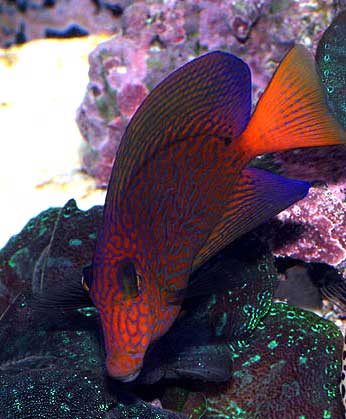 |
The juvenile color form of C. hawaiiensis is often
regarded as the most
attractive Bristletooth Tang. Photo courtesy of Greg Rothschild
of Mother
Nature's Creations.
The next consideration before purchase
will obviously have to deal with the aquarium setup itself.
A large amount of live rock is essential to the well-being
of Ctenochaetus surgeonfish. I highly recommend that
you not place these fish into aquariums that are lacking live
rock and live sand. These aquariums are often too sterile
for Bristletooth surgeonfish and oftentimes the fish will
develop mild to severe cases of Head and Lateral Line Erosion.
When provided with a large amount of live rock, a sand bed
and several glass sides of the aquarium that remain untouched
by the hobbyist, these fish can do quite well, since all of
these surfaces will be utilized for grazing by the surgeonfish.
Of course the on-going debate over aquarium
size and surgeonfish is a hotly debated on message boards
across the 'net. Though it seems no one can agree on minimum
aquarium size, it does seem everyone can agree the larger
an aquarium is, the more natural personality a fish is likely
to exhibit. Ctenochaetus species are often referred
to as the surgeonfish best suited for smaller aquariums, with
many proponents citing a minimum four-foot long aquarium.
I feel the average four-foot long aquarium is likely to not
meet all the objectives for a healthy environment for this
fish. The objectives that need to be met are ample swimming
room, and ample rockwork and sandbed for grazing, and pristine
water conditions. In order to meet one objective, you would
be likely to fail in another. For example, if you wanted to
have optimum swimming space for the fish, you'd likely fall
short on available grazing opportunities on the live rock.
However, if the minimal amount of live rock produces enough
food, it is likely your water parameters are less than optimum.
Larger amounts of live rock will reduce swimming areas, as
well as water circulation.
Naturally, I expect your current thoughts
to be looking for that "magic number" of gallons
or inches that will ensure proper husbandry of Bristletooth
tangs. I will hesitate in supplying that magic number but
instead opt to remind you of Choat and Axe (1996) and their
study regarding several Acanthurid fish and growth patterns.
Following Choat and Axe and the understanding that Acanthurids
obtain 80% of their growth in their first 15% of life, an
idea of how fast they should be growing in your aquarium can
be calculated. Combine this with an expected 35 years of age
per Acanthurid (Chaot and Axe, 1996), we come up with 80%
growth obtained in 5.25 years. For the larger Ctenochaetus
species that equals roughly seven or eight inches of length.
It is unlikely that a four-foot long aquarium will provide
a suitable environment to match these natural growth patterns.
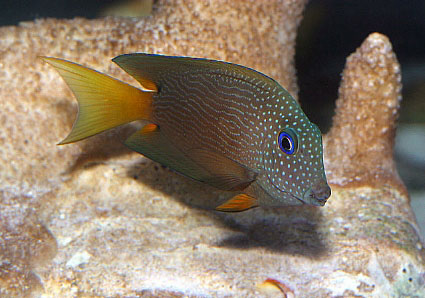 |
This C. binotatus is nearly a full adult color pattern.
Note the yellow tail still remaining
from the juvenile color form. Photo courtesy of Greg Rothschild
of Mother
Nature's Creations.
With the aquarium requirements already
discussed, I can now focus on tank mates. Generally speaking,
Bristletooth tangs will ignore most any other fish in the
aquarium. In most cases the only exception to this rule are
other Acanthurids. Even so, the problem therein lies with
the other surgeonfish harassing the Bristletooth, not the
other way around. If a second Acanthurid is to be mixed in
the same aquarium with Ctenochaetus, it is recommended
the Bristletooth be well adjusted to the aquarium prior to
addition of the second surgeonfish. Mixing two Ctenochaetus
is probably best avoided unless a pair is obtained. As far
as surgeonfish are concerned, Ctenochaetus species
are mild mannered and can become bullied by larger or more
dominant animals. Therefore, obviously, it is best to avoid
anything that may harass this surgeonfish. Their mild manners
extend to not only other fish, but also with invertebrates.
Bristletooth tangs should be considered safe with all corals.
Compatibility
chart for Ctenochaetus:
|
Fish
|
Will Co-Exist
|
May Co-Exist
|
Will Not Co-Exist
|
Notes
|
|
Angels, Dwarf
|
X
|
|
|
Should be excellent tank mates.
|
|
Angels, Large
|
X
|
|
|
Tang in first.
|
|
Anthias
|
X
|
|
|
Should be excellent tank mates.
|
|
Assessors
|
X
|
|
|
Should be excellent tank mates.
|
|
Basses
|
X
|
|
|
Should be excellent tank mates.
|
|
Batfish
|
X
|
|
|
Should be excellent tank mates.
|
|
Blennies
|
X
|
|
|
Should be excellent tank mates.
|
|
Boxfishes
|
X
|
|
|
Should be excellent tank mates.
|
|
Butterflies
|
X
|
|
|
Should be excellent tank mates.
|
|
Cardinals
|
X
|
|
|
Should be excellent tank mates.
|
|
Catfish
|
X
|
|
|
Should be excellent tank mates.
|
|
Comet
|
X
|
|
|
Should be excellent tank mates.
|
|
Cowfish
|
X
|
|
|
Should be excellent tank mates.
|
|
Damsels
|
X
|
|
|
Should be excellent tank mates.
|
|
Dottybacks
|
|
X
|
|
Some Dottybacks require dedicated aquariums.
|
|
Dragonets
|
X
|
|
|
Should be excellent tank mates.
|
|
Drums
|
X
|
|
|
Should be excellent tank mates.
|
|
Eels
|
X
|
|
|
Should be excellent tank mates.
|
|
Filefish
|
X
|
|
|
Should be excellent tank mates.
|
|
Frogfish
|
X
|
|
|
Should be excellent tank mates.
|
|
Goatfish
|
X
|
|
|
Should be excellent tank mates.
|
|
Gobies
|
X
|
|
|
Should be excellent tank mates.
|
|
Grammas
|
X
|
|
|
Should be excellent tank mates.
|
|
Groupers
|
X
|
|
|
Should be excellent tank mates.
|
|
Hamlets
|
X
|
|
|
Should be excellent tank mates.
|
|
Hawkfish
|
X
|
|
|
Should be excellent tank mates.
|
|
Jawfish
|
X
|
|
|
Jawfish in first.
|
|
Lionfish
|
|
X
|
|
Should co-exist fine, but large lions may consume juvenile
tangs
|
|
Parrotfish
|
X
|
|
|
Should be excellent tank mates.
|
|
Pineapple Fish
|
X
|
|
|
Should be excellent tank mates.
|
|
Pipefish
|
|
|
X
|
Pipefish require dedicated aquariums.
|
|
Puffers
|
X
|
|
|
Should be excellent tank mates.
|
|
Rabbitfish
|
X
|
|
|
Should be excellent tank mates.
|
|
Sand Perches
|
X
|
|
|
Should be excellent tank mates.
|
|
Scorpionfish
|
|
X
|
|
Same as Lionfish.
|
|
Seahorses
|
|
|
X
|
Seahorses require dedicated aquariums.
|
|
Snappers
|
X
|
|
|
Should be excellent tank mates.
|
|
Soapfishes
|
X
|
|
|
Should be excellent tank mates.
|
|
Soldierfish
|
X
|
|
|
Should be excellent tank mates.
|
|
Spinecheeks
|
X
|
|
|
Should be excellent tank mates.
|
|
Squirrelfish
|
X
|
|
|
Should be excellent tank mates.
|
|
Surgeonfish
|
|
X
|
|
Bristletooth in first.
|
|
Sweetlips
|
X
|
|
|
Should be excellent tank mates.
|
|
Tilefish
|
X
|
|
|
Should be excellent tank mates.
|
|
Toadfish
|
|
X
|
|
May consume juvenile tangs.
|
|
Triggerfish
|
|
X
|
|
Some Triggerfish require dedicated aquariums.
|
|
Waspfish
|
X
|
|
|
Should be excellent tank mates.
|
|
Wrasses
|
X
|
|
|
Should be excellent tank mates.
|
Note: While many of the fish listed are
good tank mates for Ctenochaetus species, you should
research each fish individually before adding it to your aquarium.
Some of the fish mentioned are better left in the ocean, or
for advanced aquarists.
The striking color pattern of the juvenile C. hawaiiensis
fades to a deep green horizontally
striped fish that appears
nealy entirely black until viewed from up close. Photo courtesy
of
Greg Rothschild
of Mother
Nature's Creations.
Meet the Species
Of the nine species of Ctenochaetus,
very few show up with any regularity in the ornamental fish
trade. Two species in particular, C. strigosus and
C. hawaiiensis, are by far the overwhelming favorites.
C. strigosus is slightly more available and definitely
more affordable, most likely due to the shallow depths they
can be found in as opposed to the 50 feet or deeper which
C. hawaiiensis typically inhabits. The solitary adults
associate with areas of dense algae growth. The Kole Tang,
as it is commonly called in the hobby, is endemic to the Hawaiian
Islands and happens to be one of the most common shore fish
of the islands. Juveniles are almost entirely lemon yellow
with a slight metallic blue trim along the edges of the dorsal
and anal fins. As the juvenile matures into an adult, it loses
all of the yellow except for a small portion that encircles
each eye. Once the yellow is gone the body takes on a shade
of rusty red to brown with blue spots or stripes flanking
the body.
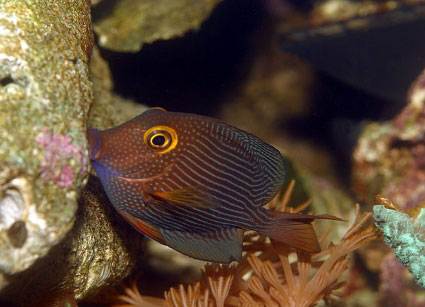 |
The adult C. strigosus has a striking yellow patch
encircling the eyes. Juveniles are
lacking this yellow mark, as well as the white spots and stripes.
Instead, they are nearly
identical to the coloration of a juvenile C. truncatus.
Photo courtesy of Greg Rothschild
of Mother
Nature's Creations.
Ctenochaetus strigosus seen here swimming in a home
aquarium. Photos courtesy
of Ken Hahn.
Ctenochaetus hawaiiensis, or the
Chevron Tang, is often considered the most attractive of the
Bristletooth surgeonfish. The juvenile is a striking orange
and blue combination. As the fish matures, the blue and orange
give way to an overall black appearance. Upon closer inspection,
dark green stripes will be found running through the black.
This fish was once thought to be endemic to the Hawaiian Islands,
but it is now known to inhabit a much larger territory stretching
from Guam to Pitcairn. It remains most numerous in the Hawaiian
Island chain, however, and all specimens showing up for retail
in the United States have been harvested in Hawaiian waters.
This is one of the larger Ctenochaetus species and
can be expected to reach nine or ten inches when provided
a suitable environment.
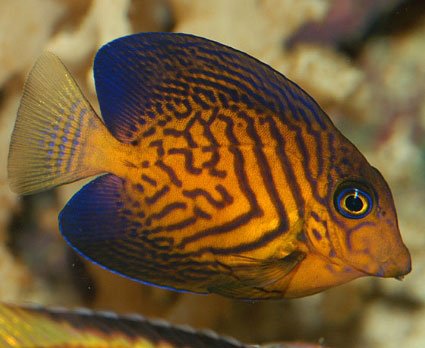 |
This photo (above) of C. hawaiiensis was taken
when the fish was likely 40mm in total length.
At this age the purple is intense. Photo courtesy of Nico
Tao (NKT). As the fish ages (below)
the purple begins to lose its intensity and the black lines
on the body begin to fade away. This
picture was probably taken near 75mm of total length. Photos
courtesy of Otto Bobis (ABahn).
The only Ctenochaetus species known
from the Red Sea is C. striatus. In the hobby these
fish are commonly called the Striped Bristletooth. Despite
a wide distribution throughout all of the Indo-Pacific except
for Hawaii, Easter, and Marquesas Islands, they are not regular
imports for the hobby. For the price C. hawaiiensis
is likely a better option. It is similar in size to C.
striatus, if not a little bit smaller.
The most aggressive Ctenochaetus
is C. tominiensis, or the Tomini Bristletooth. Originally,
this fish was thought to be endemic to the Gulf of Tomini,
but it is now known to be widespread throughout the Central
Pacific, even though it remains fairly rare in those locations.
In the home aquarium this Combtooth can be expected to harass
less aggressive fish. It has virtually little, if any, color
change associated with maturing from juvenile to adult, and
it is a very small surgeonfish, growing only to roughly five
inches.
Conclusion
Although Combtooth tangs are among the
smallest surgeonfish and the least active surgeonfish, they
still require large amounts of naturally growing food. Small
aquariums will likely not be able to keep up with their food
requirements. Although they are often thought to be strict
herbivores, it is obvious from stomach content analysis that
this is not the case, with algae making up only a small portion
of their diet. Meeting the dietary requirements for these
fish is a very important first step to their long-term success
in aquaria.
|

